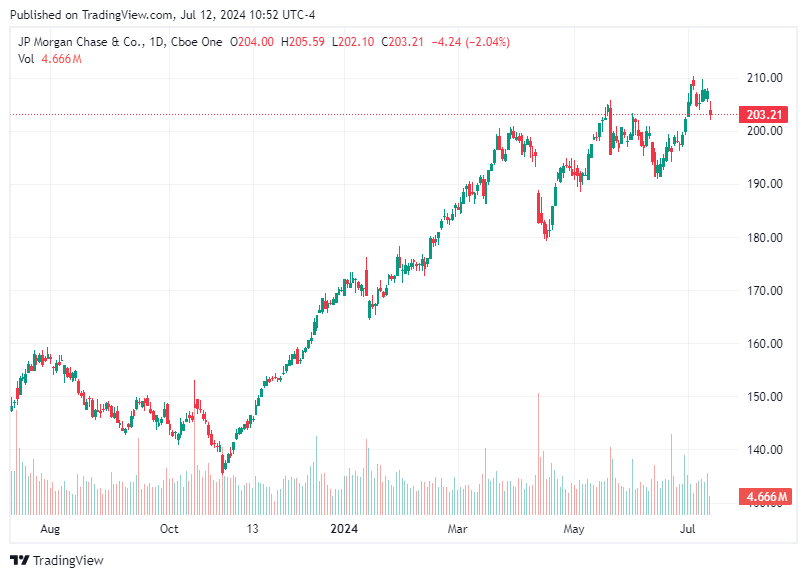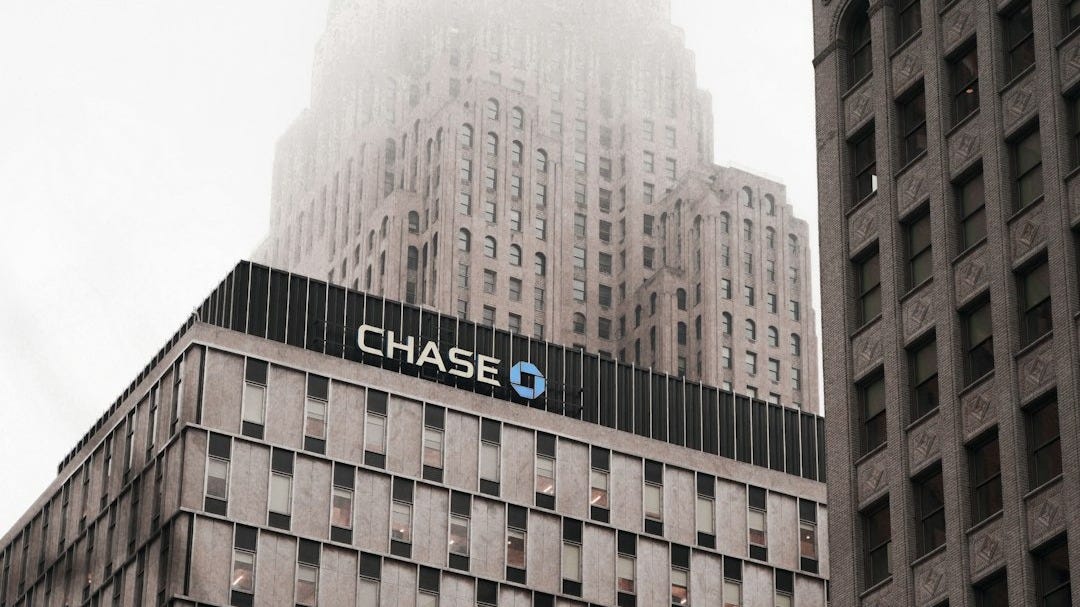JP Morgan Chase Reports Profit Decline Over Interest Rate Concerns
JPMorgan's Profit Declines Amid Interest Rate Concerns.

Disclaimer: The following article is for informational purposes only and does not constitute financial advice or a recommendation to buy or sell any securities.
Real-time information is available daily at https://stockregion.net
JPMorgan Chase, one of the largest banks in the United States, recently reported a decline in its profits, driven largely by concerns over interest rates. These findings were highlighted in JPMorgan's latest financial report, which revealed shifts in net interest income (NII) and rising deposit costs. This report comes amid broader industry challenges, as banks navigate the complexities of an evolving economic landscape marked by fluctuating interest rates and competitive pressures.
Jamie Dimon, the CEO of JPMorgan Chase, has been vocal about his outlook on interest rates, suggesting that they may remain higher than many economists anticipate. Dimon’s comments indicate a cautious approach towards future economic conditions, reflecting a broader sentiment within the banking sector. His stance reveals the uncertainty that banks face as they try to balance profitability with the demands of a competitive market. The financial turbulence isn't limited to JPMorgan Chase. Wells Fargo, another major player in the banking industry, experienced a decline in second-quarter profits, missing analysts' estimates for net interest income due to higher deposit costs. The bank's shares fell by more than 6% following this announcement, highlighting investor concerns over its financial performance.
Net interest income at Wells Fargo dropped by 9% to $11.92 billion, falling short of the average analyst expectation of $12.12 billion, according to data from LSEG. The bank reiterated that NII could decrease by 7% to 9% this year, with expectations now leaning towards the upper end of that range. Michael Santomassimo, Wells Fargo's finance chief, indicated that the bank is bracing for a more pronounced decline in NII, a critical measure of profitability.
Higher Deposit Costs and Competitive Pressures
One of the primary factors contributing to the decline in NII is the increase in average deposit costs, which rose to 1.84% in the second quarter from 1.13% a year earlier. Banks are increasingly paying more to retain customers who seek higher yields, a trend that puts pressure on their profit margins. This dynamic is exacerbated by the "higher-for-longer" interest rate environment, which discourages borrowers from taking out new loans. Santomassimo pointed out that rate expectations continue to evolve, making it challenging to predict how these changes will translate into practical outcomes for the bank. Despite these uncertainties, Wells Fargo remains cautiously optimistic about its ability to navigate the shifting economic landscape.
Wells Fargo's net income fell slightly to $4.91 billion for the three months ending June 30, compared to $4.94 billion in the same period the previous year. This modest decline reflects the broader challenges faced by the banking sector, including increased competition and fluctuating interest rates. The bank also adjusted its forecast for 2024 noninterest expenses, raising it to approximately $54 billion from the previous estimate of $52.6 billion. This increase highlights the ongoing cost pressures that Wells Fargo and other banks are grappling with as they strive to maintain profitability.
Despite the challenges in net interest income, investment banking emerged as a bright spot for Wells Fargo in the second quarter. The bank reported a 38% surge in investment banking revenue, reaching $430 million. This growth was driven by increased fees from investment banking activities, which helped offset some of the declines in NII. Under the leadership of CEO Charlie Scharf, Wells Fargo has strengthened its investment banking and trading operations, recruiting top executives from rival firms. This strategic focus has paid off, as the bank continues to see growth in fee-based revenue streams.
Rival JPMorgan Chase also benefited from a boost in investment banking, reporting a 25% increase in second-quarter profit. Citigroup too saw a substantial rise in investment banking revenue, with a 60% surge in the second quarter. These trends highlight the significance of investment banking as a revenue driver in the current financial climate.
Commercial Real Estate Challenges
Wells Fargo's exposure to commercial real estate (CRE) has been a point of concern, particularly in the office segment. The bank reported net charge-offs of $271 million for CRE, equivalent to 74 basis points of average loans. While Wells Fargo has worked to reduce its CRE exposure over the past year, the sector's ongoing troubles have necessitated increased provisions for potential defaults. Despite these challenges, executives at Wells Fargo remain confident that their CRE portfolios are manageable. The bank's proactive measures to mitigate risks in this sector reflect a broader strategy to maintain financial stability amid uncertain market conditions.
The banking sector's performance in the second quarter must be viewed within the context of broader market trends. Merger and acquisition (M&A) volumes hit $1.6 trillion globally in the first half of the year, up 20% from the previous year, according to Dealogic data. Additionally, equity capital market volumes climbed by 10% during the same period. These trends show the robust activity in investment banking, which has provided a buffer against the challenges posed by rising interest rates and increased deposit costs.
While Wells Fargo has made strides in improving its financial performance, the bank remains constrained by a $1.95 trillion asset cap imposed by regulators. This cap, a legacy of the fake accounts scandal, prevents the bank from expanding its asset base until it addresses underlying issues to the satisfaction of regulators. This regulatory constraint poses an additional challenge for Wells Fargo as it seeks to grow and compete in the market.
The recent financial reports from JPMorgan Chase and Wells Fargo paint a complex picture of the banking sector's current state. Despite declines in net interest income and rising deposit costs, both banks have shown resilience through their investment banking activities. Leaders like Jamie Dimon and Charlie Scharf continue to navigate their institutions through these turbulent times, adjusting strategies to meet evolving market conditions.
As interest rate expectations remain fluid and competitive pressures persist, banks must continue to adapt to maintain profitability and investor confidence. The insights gleaned from these financial reports offer a glimpse into the challenges and opportunities that lie ahead for the banking sector.
Disclaimer: The information provided in this article is based on publicly available data and is intended for general informational purposes only. It does not constitute financial advice or recommendations for any specific investments.
Real-time information is available daily at https://stockregion.net




